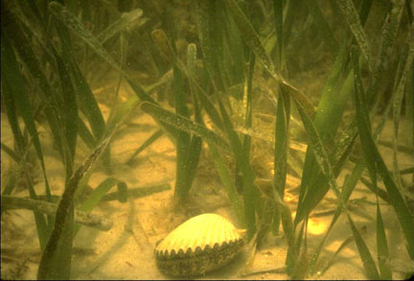

 |
||||||
 |
||||||
Uneven Seagrass Recovery Prompts Closer Look
By Victoria Parsons
Across Tampa Bay, in most places and in most years, seagrasses are staging a comeback. Holding the line on excess nutrients has generally increased water clarity, allowing seagrass meadows to thrive in areas where water was once so cloudy they died off. |
|
©R.C. Phillips 1960 Important habitat for bay residents ranging from snook and shrimp to manatees, seagrasses also are considered an “indicator species” of the bay’s overall health. Except for the El Nino years of 1997-1998 when heavy rains generated increased stormwater runoff, seagrasses are generally rebounding in most sections of the bay. Aerial studies and digitized maps produced by the Southwest Florida Water Management District show more than 2000 acres of new seagrasses from 1999 to 2004. |
But that’s not true in every segment of the bay – and nutrients aren’t always the most critical issue. A new report from the Environmental Protection Commission of Hillsborough County details the differences so that managers can make the best possible decisions.
“We drilled down from the state and regional level to the county level, and then went a step further,” notes Gerold Morrison, director of EPC’s environmental management division. “Once we identified specific seagrass management areas, we could see the different issues and decide how to prioritize actions to protect the resources.”
Until recently, the most important problem across Tampa Bay was excessive levels of nutrients that fueled the growth of algae and blocked sunlight from reaching seagrass. With major improvements in nutrient loadings – beginning in the late 1980s after new regulations mandated advanced wastewater treatment – other concerns are becoming equally important in some parts of the bay.
For instance, wave energy, possibly caused by the loss of longshore bars, appears to be an important issue for regrowth of seagrasses near MacDill Air Force Base, in eastern Hillsborough Bay and Middle Tampa Bay near the booming SouthShore district. Boating impacts, specifically propeller scars, are an important issue in the Cockroach Bay area.
Water quality, however, remains the top obstacle to seagrass growth in other locations, including northern and eastern Old Tampa Bay and western Hillsborough Bay, and an issue of concern in all bay sectors as the region’s population continues to grow.
With priorities set for individual bay segments, the EPC will take a comprehensive management plan to its board for approval in early 2007 with the support of the Agency on Bay Management.
Prop Scarring an Issue Baywide
Prop scarring appears to be an important management issue in several segments of the bay – and it’s likely to become controversial. Seagrasses need sunlight to grow, so they are limited to the shallow waters that rim the bay where water is generally less than six feet deep.
“Scarring is increasing in many areas and we’re looking at options that would protect seagrasses while still allowing access by boat,” said Ed Sherwood, EPC environmental scientist. In spite of new slow-speed and no-motor zones, Tampa Bay has a higher percentage of seagrasses with prop scarring than anywhere in the state except the Florida Keys.
Once scarred, seagrasses may remain damaged for years or even decades.
While the plan proposes no specific enforcement actions, managers recommend a four-point plan like that enacted in the Florida Keys National Marine Sanctuary. “It’s been successful there, allowing boaters in but still limiting damage,” Morrison said. The four points – education, channel marking, increased enforcement and limited-motoring zones – work together to protect valuable seagrasses.
Landmark Longshore Bar Study Underway
Historically, Tampa Bay was lined with sandy bars located just offshore with seagrasses growing on both sides of them. Scientists theorize that these longshore bars protected seagrass beds from increased wave action, particularly from the wakes of large ships.
|
State Looks at Seagrass Scarring |
|
Seagrass scarring across the state has become such an important issue that the Florida Fish and Wildlife Conservation Commission proposed regulations that would fine boaters for damaging seagrass beds. The legislation, developed with input from a 25-member advisory group of stakeholders, calls for a minimal fine of $50 for the first offense, escalating to $1000 for the fourth offense within 36 months. “The damage continues to increase,” notes Kent Smith, biological administrator for the FFWC. “We did an aerial survey in 1995, and documented more than 170,000 acres of damaged seagrass beds. In a spot check, we reassessed Charlotte Harbor last year and found an increase of 9000 acres, and the damage was more intense as well as widespread.” The $50 fine is designed to catch the attention of boaters who destroy seagrasses “but if they do it again and again, they need to suffer the consequences,” Smith said. Smith presented the proposed legislation to the commission late last year, but it may not go to the legislature until 2008. |
A new $560,000 study, funded through grants from the Pinellas County Environmental Fund, the Gulf of Mexico Program, US Geological Survey, US Fish and Wildlife Service, and the Hillsborough County Pollution Recovery Trust Fund, will allow scientists to test a series of hypotheses, including a chicken-and-egg question.
“One of the big questions is – ‘Do the longshore bars allow seagrasses to grow or do seagrass beds help to build longshore bars?’ ” says Holly Greening, senior scientist with the Tampa Bay Estuary Program. “We hardly ever get the chance to compare two completely different hypotheses.”
A 400-foot bar will be built off MacDill in late spring or early summer in a no-entry zone where propeller scarring won’t be an issue but wave action is the top concern. The bar will be broken down into 100-foot segments, each built with different construction methods to see which is most effective.
That section of the restoration will be compared with a large area of seagrasses planted last summer in a separate study of whether seagrasses can be transplanted more effectively when in larger pieces.
“We planted relatively large squares – each about eight inches and 25 to 30 pounds– that took a very significant manual effort from the City of Tampa and volunteers from Tampa Bay Watch,” Greening said. “We’ll do a six-month evaluation in mid-January but the photos look great and it appears that the seagrasses are expanding.”
New Look at Nitrogen
Since the early 1990s, bay managers have focused on “holding the line” on nitrogen as the centerpiece of seagrass recovery efforts. Models indicate that implementing projects that provide net reductions of about 17 tons of nitrogen per year will result in water clarity that allows seagrass coverage to rebound to 1950 levels.
Continued population growth, however, makes holding the line harder and the EPC has proposed enhanced buffers to protect wetlands and surface waters from contaminants in new developments.
“The long-term plan is to develop a technical manual that would describe how tiered buffer zones should be designed, constructed and maintained on each site,” Morrison said. “The state recently adopted tiered buffer zones for agricultural uses with a minimum width of 55 feet, so expanding the setback to 50 feet is a logical first step until the technical manual is complete.”
Across the country, riparian buffer zones are considered a cost-effective method of protecting wetlands and surface waters and they have become a key element in the restoration of Chesapeake Bay, Morrison said. “There is still some work to do locally, but the state rules make it clear that buffer zones are as effective in Florida as they are in other parts of the country.”